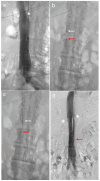Inferior Vena Cava Filter in Cancer-Associated Thrombosis: A Vade Mecum for the Treating Physicians: A Narrative Review
- PMID: 39457543
- PMCID: PMC11505388
- DOI: 10.3390/biomedicines12102230
Inferior Vena Cava Filter in Cancer-Associated Thrombosis: A Vade Mecum for the Treating Physicians: A Narrative Review
Abstract
Cancer is a remarkable prothrombotic disease, and cancer-associated thrombosis acts as a dreadful omen for poor prognosis. The cornerstone of venous thromboembolism therapy is anticoagulation; however, in patients with venous thromboembolism who are not suitable for anticoagulation (contraindication, failure, or complication), the inferior vena cava filter appears a valuable option in the therapeutic arsenal. The recently heightened trend of steady rise in filter placement mirrors the spread of retrievable devices, together with improvements in physicians' insertion ability, medico-legal issue, and novel and fewer thrombogenic materials. Nevertheless, the exact role of the inferior vena cava filter in cancer has yet to be endorsed due to a dearth of robust evidence. Indeed, data that support the inferior vena cava filter are weak and even controversial, resulting in discrepancies in the interpretation and application of guidelines in daily practice. In this narrative review, we aim at clarifying the state of the art on inferior vena cava filter use in malignancies. Furthermore, we provide a feasible, conclusive 4-step algorithm for the treating physicians in order to offer a practical strategy to successfully employ the inferior vena cava filter as a priceless device in the current armamentarium against cancer.
Keywords: cancer; inferior vena cava filter; venous thromboembolism.
Conflict of interest statement
C.G.T. reports honoraria or consultation fees from VivaLyfe, Univers Formazione, Solaris, Summeet, AstraZeneca, Myocardial Solutions, Medtronic; funding from Amgen and MSD; and is listed as an inventor of two patents related to HF, outside the submitted work. The other authors declare no conflicts of interest.
Figures



References
Publication types
LinkOut - more resources
Full Text Sources

